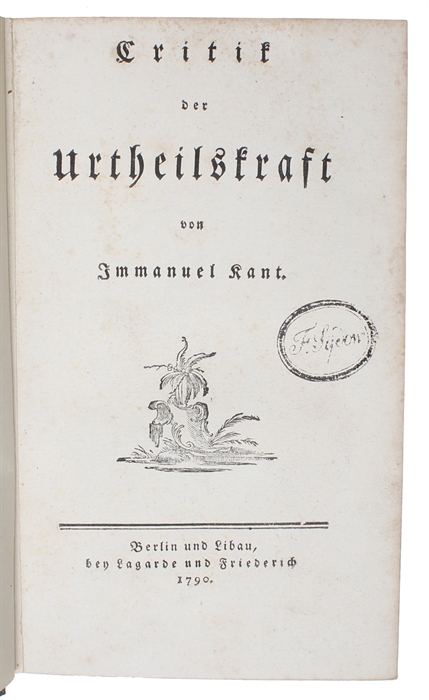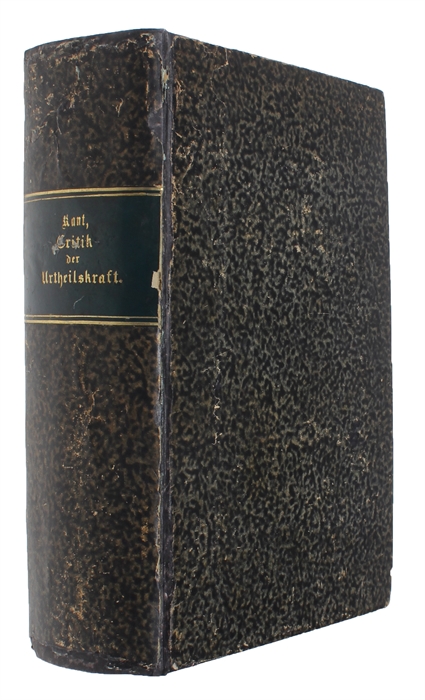ONE OF FOUR OR FIVE COPIES PRINTED ON SPECIAL PAPER
KANT, IMMANUEL.
Critik der Urtheilskraft.
Berlin u. Libau, Lagarde und Friederich, 1790.
8vo (204 x 135 x 60 mm). Near contemporary marbled paper binding with gilt green title-label to spine. Hinges and capitals neatly restored. Old ownership-stamp to title-page. Mid-nineteenth-century Viennese bookseller's label to pasted-down back end-paper. Occasional light foxing in some margins, otherwise clean and bright. Printed on special, heavy paper, making the volume nearly double the thickness of regular copies. LVIII, 476 pp., (1) f. (errata).
Extremely rare copy, printed on special paper, of the first edition of Kant's seminal "Critique of Judgment", the third and last of his critiques, which "Kant himself regarded [..] as the coping-stone of his critical edifice; it even formed the point of departure for his successors, Fichte, Schelling and Hegel, in the construction of their respective systems." (J.H. Bernard in the introduction to his translation of "Critique of Judgment).
THIS MAGNIFICENT COPY IS UNLIKE ANY OTHER WE HAVE SEEN - ONE OF ONLY FOUR OR FIVE PRESENTATION-COPIES PRINTED ON SPECIAL PAPER THAT KANT HIMSELF REQUESTED FROM THE PRINTER, TO BE GIVEN TO A HANDFUL OF NAMED RECIPIENTS.
From a letter to Lagarde from January 21st 1790 (see "Briefwechsel von Imm. Kant", ed. Fischer, Müller, 1912, pp. 110-11), we know that Kant had requested 20 author's copies, four of them to be printed on special paper. While the book was in the press, Kant sent Lagarde a list of presentees to whom copies on special paper should be sent. He now named five recipients, so we assume that five copies were printed on special paper, instead of the original requested four copies. The recipients were: Count J.N. Windisch-Grätz, F.H Jacobi, K.L. Reinhold, L.H. Jacob and J.F. Blumenbach (see letter to Lagarde, March 25th, 1790, "Briefwechsel von Imm. Kant", ed. Fischer, Müller, 1912, pp. 126-7). As far as we know, none of these five presentation-copies have been traced and we have never seen one of them before. Neither do we know which of the five recipients received the present copy.
Together with his two other critiques, the "Critique of Judgment" arguably constitutes the most important contribution to philosophy since Aristotle and Plato. Kant's seminal third critique was extremely influential from the time of its appearance - Goethe said said it was the first philosophical book ever to move him, and Fichte called it "the crown of the critical philosophy"; "...not only did Goethe think highly of it, but it received a large measure of attention in France as well as in Germany on its first appearance. Originally published at Berlin in 1790, a Second Edition was called for in 1793; and a French translation was made by Imhoff in 1796. Other French versions are those by Keratry and Weyland in 1823, and by Barni in 1846." (J.H. Bernard).
In the "Critique of Judgment", Kant develops philosophical aesthetics and teleology that comprises nature and art. This aesthetics fulfills an essential systematic function in the Kantian architectonic. It bridges the gap between reason and nature, thus serving as a complement to practical reason of which Kant had proposed a critique two years earlier.
The third critique is essential to an understanding of Kant's project of a critical philosophy. It is here that he seeks to join the dimensions of human experience which he had laid bare in the two previous critiques. A number of the conceptual foundations he had laid from 1782 break down, as he tries to demonstrate that aesthetics mediates between the realm of sensibility and that of reason.
In order to do so, he sets out to show that aesthetic intuition ranges over both realms. The key to this demonstration is the claim that the two realms are isomorphic. However, as Kant considers the aesthetic judgment of the products of man's artistic invention, he cannot fit them into the format of a teleology of nature. Instead, he develops a conceptual framework for aesthetic judgment which explains why the first section on the faculty of aesthetic judgment swelled to the point of dwarfing the section on the teleology of nature.
In the third critique the tension which inhere in the project of a critical philosophy rises to the surface. The third critique thus provides us with an invaluable glimpse into the actual workings of the mental faculties that Kant attempted to chart in his philosophy. For this very reason, the third critique provided the point of departure for much of later idealist philosophy, especially that of Hegel whose speculative philosophy can be seen as an articulation of the topics which Kant had uncovered in the third critique.
"...the Critique of Judgement completes the whole undertaking of criticism; its endeavour is to show that there are a priori principles at the basis of Judgement just as there are in the case of Understanding and of Reason; that these principles, like the principles of Reason, are not constitutive but only regulative of experience, i.e. that they do not teach us anything positive about the characteristics of objects, but only indicate the conditions under which we find it necessary to view them; and lastly, that we are thus furnished with an a priori philosophy of pleasure." (J.H. Barnard).
Warda: 125.
Order-nr.: 57178


